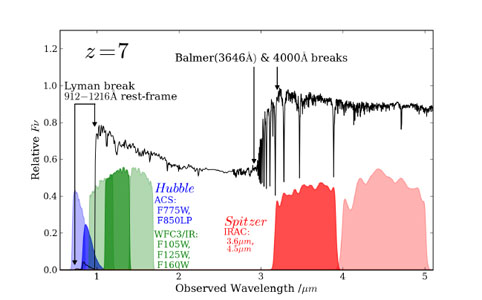Why some photo-z in CSST is under/over-estimated?
How to get the photon-z

To get the redshift of a galaxy, the feature of its speecturm should be utilized. The most common way is to use the Lyman break or Balmer break, which is the drop of flux at the wavelength of
where
The break can be mistaken
By measuring the flux in a series of narrow bands,

Photon-z versus Spec-z
For an instance, for a galaxy at redshift
The redshift is over-estimated by a factor of
Other breaks
Yes, apart from the Lyman break, there are several other breaks or discontinuities observed in the astronomical spectrum. These breaks occur at specific wavelengths and are caused by various physical processes.
Balmer Break: The Balmer break is a discontinuity observed in the optical spectrum of stars. It occurs at a wavelength of approximately
(Angstroms) and is caused by the absorption of photons by hydrogen atoms in the star's outer atmosphere. This break is particularly prominent in hot, young stars. Paschen Break: Similar to the Balmer break, the Paschen break is observed in the infrared spectrum of stars. It occurs at a longer wavelength of around
and is caused by the absorption of photons by hydrogen atoms in the star's outer atmosphere. The Paschen break is more prominent in cooler stars compared to the Balmer break. Werner Break: The Werner break is a discontinuity observed in the ultraviolet spectrum of stars. It occurs at a wavelength of approximately
and is caused by the absorption of photons by neutral hydrogen atoms in the interstellar medium. This break is significant in studying the properties of interstellar gas and the formation of stars. Break: The break, also known as the Balmer/ break, is a discontinuity observed in the optical spectrum of galaxies. It occurs at a wavelength of around and is caused by the combined effect of the Balmer break and metal absorption lines. This break is used to study the age and stellar populations of galaxies.
These breaks in the astronomical spectrum provide valuable information about the physical properties of celestial objects, such as their temperature, composition, and age. By analyzing these breaks, astronomers can gain insights into the nature and evolution of stars, galaxies, and the universe as a whole.